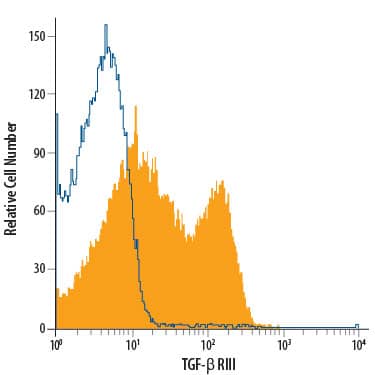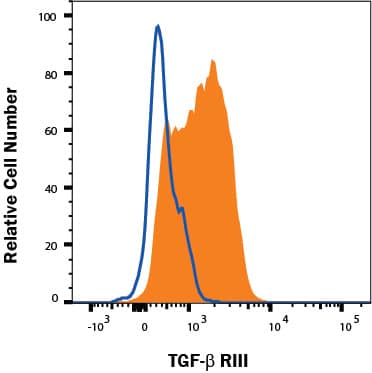Human TGF-beta RIII PE-conjugated Antibody
R&D Systems, part of Bio-Techne | Catalog # FAB242P


Key Product Details
Species Reactivity
Validated:
Cited:
Applications
Validated:
Cited:
Label
Antibody Source
Product Specifications
Immunogen
Gly21-Asp781
Accession # AAA67061
Specificity
Clonality
Host
Isotype
Scientific Data Images for Human TGF-beta RIII PE-conjugated Antibody
Detection of TGF‑ beta RIII in Human Blood Lymphocytes by Flow Cytometry.
Human peripheral blood lymphocytes were stained with Goat Anti-Human TGF-beta RIII PE-conjugated Antigen Affinity-purified Polyclonal Antibody (Catalog # FAB242P, filled histogram) or isotype control antibody (Catalog # IC108P, open histogram). View our protocol for Staining Membrane-associated Proteins.Detection of TGF‑ beta RIII in Human MCF-7 Cell Line by Flow Cytometry
MCF-7 human breast adenocarcinoma cell line was stained with Goat Anti-Human TGF-beta RIII PE-conjugated Antigen Affinity-purified Polyclonal Antibody (Catalog # FAB242P, filled histogram) or isotype control antibody (IC108P, open histogram). View our protocol for Staining Membrane-associated Proteins.Applications for Human TGF-beta RIII PE-conjugated Antibody
Flow Cytometry
Sample: Human MCF-7 breast adenocarcinoma cell line and peripheral blood lymphocytes
Formulation, Preparation, and Storage
Purification
Formulation
Shipping
Stability & Storage
- 12 months from date of receipt, 2 to 8 °C as supplied.
Background: TGF-beta RIII
Most cell types express three sizes of receptors for TGF-beta. These are designated Type I (53 kDa), Type II (70-85 kDa), and Type III (250-350 kDa). The Type I receptor is a membrane-bound serine/threonine kinase that apparently requires the presence of the Type II receptor to bind TGF-beta. The Type II receptor is also a membrane-bound serine/threonine kinase that binds TGF-beta 1 and TGF-beta 3 with high affinity and TGF-beta 2 with a much lower affinity. The Type I and Type II receptors together form a heterodimeric signaling complex that is essential for the transduction of the anti-proliferative signals of TGF-beta.
The Type III receptor is a transmembrane proteoglycan with a large extracellular domain and a 43 amino acid residue cytoplasmic domain. The cytoplasmic domain of the Type III receptor lacks an obvious signaling motif and the receptor may not be involved directly in signal transduction. The Type III receptor binds TGF-beta 2 with the highest affinity. Other TGF-beta isoforms also bind the Type III receptor, but with lower affinities. Cellular responsiveness to TGF-beta 2 appears to be dependent on the presence of the Type III receptor which can interact with the signaling receptor complex. In addition to the transmembrane Type III receptor, a soluble form of the receptor is secreted by some cell types. The physiological role of this soluble receptor remains to be determined. The recombinant TGF-beta soluble receptor Type III binds the TGF-beta isoforms differentially in solution and exhibits TGF-beta antagonistic activities in vitro.
Long Name
Alternate Names
Gene Symbol
UniProt
Additional TGF-beta RIII Products
Product Documents for Human TGF-beta RIII PE-conjugated Antibody
Product Specific Notices for Human TGF-beta RIII PE-conjugated Antibody
For research use only
